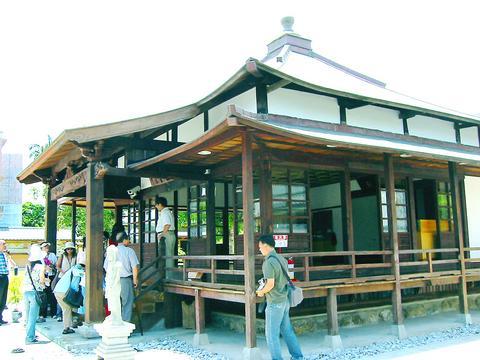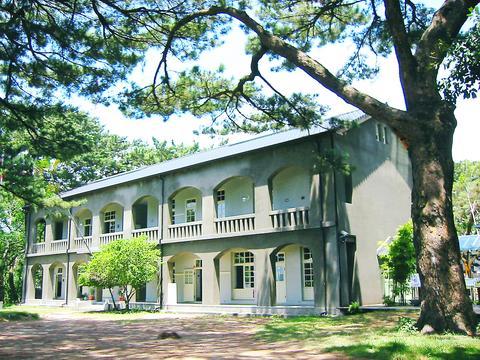With an exemplary new tour route of its abundant historical sites, Hualien County is ready to unfold its charm and spectacular scenery to visitors.
The tour is one of six routes that are being promoted by the Council for Cultural Affairs (CCA), to encourage local and foreign tourists to learn more about the nation's culture through its architectural heritage. The other tours will take visitors to sites in Jinmen County, Penghu County, Tainan, northern Taiwan and Taichung.

PHOTO: JEWEL HUANG, TAIPEI TIMES
The Council for Cultural Affairs (CCA) is marking about 500 historical sites around the country with a round logo and organizing this architecture as tourist spots in the "Tour of Taiwan's Classical Historical Buildings." The tour is a key project that the CCA started promoting this month, aiming to implement the Cultural Citizenship Campaign and the Citizens' Esthetics Movement, two policies initiated by Chen Chi-nan (

PHOTO: JEWEL HUANG, TAIPEI TIMES
"There are many historical buildings which may not be old enough to be preserved as national historic spots, but they tell us so many stories about this land," Chen said at a news conference last week announcing the debut of the tour. "They are like chapters of the history of Taiwanese culture," Chen said.
Chen said the new tours tap into the Cultural Heritage Preservation Law's (
One of the six routes on the tour will visit Hualien's old buildings, and reveal the county's complicated cultural and historical legacy left by its diverse residents over the past 300 years -- who include Aborigines, Japanese, Hakka, Hoklo and Mainlanders.
"In addition to its famous Taroko National Park, Hualien is a wonderland of diverse cultures and ethnic groups," said Ruan Chang-rui (
The CCA has launched a website for people who are interested in the tour, at http://hbtravel.cca.gov.tw. The council especially recommends the following historical sites to tourists who want to get acquainted -- or re-acquainted -- with Hualien.
Pine Garden
Built in 1943, Hualien City's Pine Garden used to be the military base for the Japanese Navy stationed there during World War II. Soon it became a recreational resort for high-ranking Japanese officers. It was said that the Pine Garden was the place where kamikaze pilots would drink the wine bestowed by the Japanese emperor on the eve of their suicide missions, according to the manager of Pine Garden, Lin Cheng-tsung (
With nearly 200 pines, the tranquil garden faces the estuary of the Meilun River to the Pacific Ocean. After being restored by the Hualien County government, the garden was officially recognized as one of Taiwan's "top 100 historic charms" in 2001. It features afternoon tea for tourists.
Ching-shiu Temple
Built in Jian in 1917 by Japanese immigrants, Ching-shiu Temple is the only Japanese temple that is completely preserved in Taiwan. Chian township (
There are 88 stone Buddhas moved from the same number of temples in Shikoku, according to Huang Jung-tun (
Tobacco-roasting Houses
About 35 old tobacco-roasting houses in Fenglin recall the once-booming tobacco industry, which began during the period of Japanese rule.
However, although realizing the historical value of the tobacco-roasting houses, the Hualien city government has not yet restored these old buildings because of insufficient funds in their budget.
Old house of Fataan Tribe
Built in Kuangfu between 1924 to 1929 by Bawon Buting, a chieftain of Fataan Tribe, an Amis tribe in Hualien County.
The old tribe house reveals the matriarchal tradition of the Amis tribes.
The house was divided by the daughters of Bawon Buting, and most of the utensils used since as far back as the 1930s have been well preserved.

ANOTHER EMERGES: The CWA yesterday said this year’s fourth storm of the typhoon season had formed in the South China Sea, but was not expected to affect Taiwan Tropical Storm Gaemi has intensified slightly as it heads toward Taiwan, where it is expected to affect the country in the coming days, the Central Weather Administration (CWA) said yesterday. As of 8am yesterday, the 120km-radius storm was 800km southeast of Oluanpi (鵝鑾鼻), Taiwan’s southernmost tip, moving at 9kph northwest, the agency said. A sea warning for Gaemi could be issued tonight at the earliest, it said, adding that the storm is projected to be closest to Taiwan on Wednesday or Thursday. Gaemi’s potential effect on Taiwan remains unclear, as that would depend on its direction, radius and intensity, forecasters said. Former Weather Forecast

As COVID-19 cases in Japan have been increasing for 10 consecutive weeks, people should get vaccinated before visiting the nation, the Centers for Disease Control (CDC) said. The centers reported 773 hospitalizations and 124 deaths related to COVID-19 in Taiwan last week. CDC Epidemic Intelligence Center Director Guo Hung-wei (郭宏偉) on Tuesday said the number of weekly COVID-19 cases reported in Japan has been increasing since mid-May and surpassed 55,000 cases from July 8 to July 14. The average number of COVID-19 patients at Japan’s healthcare facilities that week was also 1.39 times that of the week before and KP.3 is the dominant

The Chinese Communist Party’s (CCP) working group for Taiwan-related policies is likely to be upgraded to a committee-level body, a report commissioned by the Mainland Affairs Council (MAC) said. As Chinese President Xi Jinping (習近平) is increasingly likely to upgrade the CCP’s Central Leading Group for Taiwan Affairs, Taiwanese authorities should prepare by researching Xi and the CCP, the report said. At the third plenary session of the 20th Central Committee of the CCP, which ended on Thursday last week, the party set a target of 2029 for the completion of some tasks, meaning that Xi is likely preparing to

US-CHINA TRADE DISPUTE: Despite Beijing’s offer of preferential treatment, the lure of China has dimmed as Taiwanese and international investors move out Japan and the US have become the favored destinations for Taiwanese graduates as China’s attraction has waned over the years, the Ministry of Labor said. According to the ministry’s latest income and employment advisory published this month, 3,215 Taiwanese university graduates from the class of 2020 went to Japan, surpassing for the first time the 2,881 graduates who went to China. A total of 2,300 graduates from the class of 2021 went to the US, compared with the 2,262 who went to China, the document showed. The trend continued for the class of 2023, of whom 1,460 went to Japan, 1,334 went to